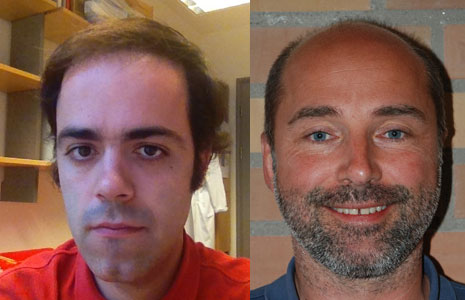Human lung macrophages are self-maintained for several years

The classical view of tissue macrophages is that they are continuously replaced by blood monocytes, but a paper first-authored by Ibon Eguiluz-Gracia (photo) from Frode Jahnsen's group at the Department of Pathology at OUH and the Centre for Immune Regulation at UiO, recently published in Thorax (journal impact factor 8.3), show that human alveolar macrophages are self-maintained within the lungs for many years. This may be important for development of chronic graft rejection, which is a common complication after lung transplantation and remains the major obstacle to better long-term outcomes.
Furthermore, as pointed out in the accompanying Editorial in Thorax, this study has potential implications for treatment of patients with alveolar proteinosis and COPD.
Alveolar macrophages are critical for lung function – both as phagocytes and as regulators of immune responses, and as regulators of the surfactant layer coating the alveolar epithelium. In fact, defects in the ability of alveolar macrophages to clear surfactant lead to life-threatening respiratory insufficiency – and direct transfer of macrophages into the lungs has recently been suggested as a treatment modality for such diseases. However, more knowledge about the longevity and progenitors of human alveolar macrophages is needed to determine the therapeutic potential of such treatment in humans. In a lung transplantation setting, alveolar macrophages have the potential to activate allogeneic T cells in the grafts, and may be involved in development of chronic graft rejection, which remains the major obstacle to long-term graft survival. It is therefore important to determine the lifetime of such macrophages in vivo.
To this end, Ibon Eguiluz-Gracia and colleagues at the Centre for Immune Regulation (CIR) and the Department of Pathology at OUS, together with collaborators from Lund University and Rigshospitalet in Copenhagen, employed a quite novel approach to directly measure the turnover of tissue macrophages. By studying lung biopsies taken regularly over more than 100 weeks from patients receiving lung transplants from gender-mismatched donors, the authors were able to directly assess the presence of donor- and recipient-derived macrophages based on X/Y-chromsome detection. They found that the number of donor-derived alveolar macrophages was unchanged during the 2 year post-transplantation period. A fraction of the macrophages proliferated locally, showing that such cells have the capacity to self-renew. They also found that recipient monocytes seeded the alveoli early after transplantation, and developed into proliferating mature macrophages. This resulted in a stable mixed chimerism between donor and recipient cells throughout the 2-year period.
Links:
Long-term persistence of human donor alveolar macrophages in lung transplant recipients.
Eguíluz-Gracia I, Schultz HH, Sikkeland LI, Danilova E, Holm AM, Pronk CJ, Agace WW, Iversen M, Andersen C, Jahnsen FL, Baekkevold ES.
Thorax. 2016 Nov;71(11):1006-1011. doi: 10.1136/thoraxjnl-2016-208292.
PMID: 27329043
Editorial:
Lung macrophages: old hands required rather than new blood?
Staples KJ.
Thorax. 2016 Nov;71(11):973-974. doi: 10.1136/thoraxjnl-2016-208992. No abstract available.
PMID: 27531530
Research groups - CIR - Centre for Immune Regulation, UiO